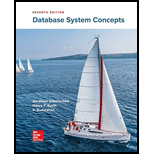
Data Definition Language (DDL): It is used for creating tables and other structures. They perform operations like, creating tables, modifying
Table Creation:
Creating table comes under Data Definition Language (DDL). Syntax for creating table is as follows:
CREATE TABLE TABLE_NAME (
Column1 datatype,
Column2 datatype,
…
);
Explanation of Solution
b.
Query:
create table company(company_name varchar2(50) primary key, city varchar2(50));
Explanation:
The above q...
Explanation of Solution
c.
Query:
create table works(employee_name varchar2(50), company_name varchar2(50), salary number(10, 2), foreign key (employee_name) references employee(employee_name), foreign key(company_name)references company(company_name));
Explanation of Solution
d.
Query:
create table manages(employee_name varchar2(50), manager_name varchar2(50) primary key, foreign key(employee_name) references employee(employee_name));
Explanation:
...
Explanation of Solution
e.
Query:
create table participated (report_number char(20) primary key, license char(20) references car, driver_id char(20) references driver, damage_amount dec(6,2) )
Explanation:
The above query is used creat...
Want to see the full answer?
Check out a sample textbook solution
Chapter 21 Solutions
EBK DATABASE SYSTEM CONCEPTS
- this module is java 371. please answer all questions correctly , include all comments etc and follow all requirements. Question 1: (40 MARKS) E-Hailing Bicycle Management System Case Study:An e-hailing company that rents out bicycles needs a system to manage its bicycles, users, and borrowing process. Each user can borrow up to 2 bicycles at a time, specifically for families with children 18 years or below. The system must track the bicycles (name, make, type, and availability) and users (name, ID, and borrowed bicycles). The company also wants to ensure that the system uses a multidimensional array to store information about the bicycles. Requirements: Add and View Bicycles: Borrow Bicycles: Return Bicycles Display Borrowed Bicycles and Search for a bicycle Create a menu-driven program to implement the above. Sample Output: Add Bicycle View All Bicycles Borrow Bicycle Return Bicycle View Borrowed Bicycles Search Bicycle ExitEnter your choice: Question 2…arrow_forwardwhat are some available cloud components, types, delivery models, and configurations in web services and cloud computing? thanksarrow_forwardI would like to get information to know features about the following concepts: 1. Anything as a Server (XaaS) 2. Block Storage 3. WebSocketarrow_forward
- Please answer JAVA OOP problem below: You are working at a university that tracks students. Each student is identified by their name and faculty advisor. Each faculty advisor is identified by their name, department, and maximum number of students they can advise. Using solid OO design principles, create a modular program that implements all the classes for the problem and also creates an implementation class that gathers user input for one student and then prints out the information gathered by creating the appropriate data definition and implementation classes. All data must be validated. I have given the code so far: Implementation: import javax.swing.JOptionPane; public class Implementation { public static void main(String[] args) { FacultyAdvisor facultyAdvisor = new FacultyAdvisor("Sharmin Sultana", "IT", 30); Student student = new Student("John", facultyAdvisor); JOptionPane.showMessageDialog(null, student.toString()); } } Student: public…arrow_forwardExercise 1 Function and Structure [30 pts] Please debug the following program and answer the following questions. There is a cycle in a linked list if some node in the list can be reached again by continuously following the next pointer. #include typedef struct node { int value; struct node *next; } node; int 11_has_cycle (node *first) if (first == node *head { NULL) return 0;B = first; while (head->next != NULL) { if (head == first) { return 1; } head head->next; } return 0; void test_11_has_cycle() { int i; node nodes [6]; for (i = 0; i < 6; i++) nodes [i] .next = NULL; nodes [i].value i; } nodes [0] .next = &nodes [1]; nodes [1] .next = &nodes [2]; nodes [2] .next = &nodes [3]; nodes [3] .next = & nodes [4]; nodes [4] .next = NULL; nodes [5] .next = &nodes [0]; printf("1. Checking first list for cycles. \n Function 11_has_cycle says it hass cycle\n\n", 11_has_cycle (&nodes [0]) ?"a":"no"); printf("2. Checking length-zero list for cycles. \n Function 11_has_cycle says it has %s…arrow_forwardcheckpoint exercice for my students for Amortized Analysisarrow_forward
 Database System ConceptsComputer ScienceISBN:9780078022159Author:Abraham Silberschatz Professor, Henry F. Korth, S. SudarshanPublisher:McGraw-Hill Education
Database System ConceptsComputer ScienceISBN:9780078022159Author:Abraham Silberschatz Professor, Henry F. Korth, S. SudarshanPublisher:McGraw-Hill Education Starting Out with Python (4th Edition)Computer ScienceISBN:9780134444321Author:Tony GaddisPublisher:PEARSON
Starting Out with Python (4th Edition)Computer ScienceISBN:9780134444321Author:Tony GaddisPublisher:PEARSON Digital Fundamentals (11th Edition)Computer ScienceISBN:9780132737968Author:Thomas L. FloydPublisher:PEARSON
Digital Fundamentals (11th Edition)Computer ScienceISBN:9780132737968Author:Thomas L. FloydPublisher:PEARSON C How to Program (8th Edition)Computer ScienceISBN:9780133976892Author:Paul J. Deitel, Harvey DeitelPublisher:PEARSON
C How to Program (8th Edition)Computer ScienceISBN:9780133976892Author:Paul J. Deitel, Harvey DeitelPublisher:PEARSON Database Systems: Design, Implementation, & Manag...Computer ScienceISBN:9781337627900Author:Carlos Coronel, Steven MorrisPublisher:Cengage Learning
Database Systems: Design, Implementation, & Manag...Computer ScienceISBN:9781337627900Author:Carlos Coronel, Steven MorrisPublisher:Cengage Learning Programmable Logic ControllersComputer ScienceISBN:9780073373843Author:Frank D. PetruzellaPublisher:McGraw-Hill Education
Programmable Logic ControllersComputer ScienceISBN:9780073373843Author:Frank D. PetruzellaPublisher:McGraw-Hill Education





